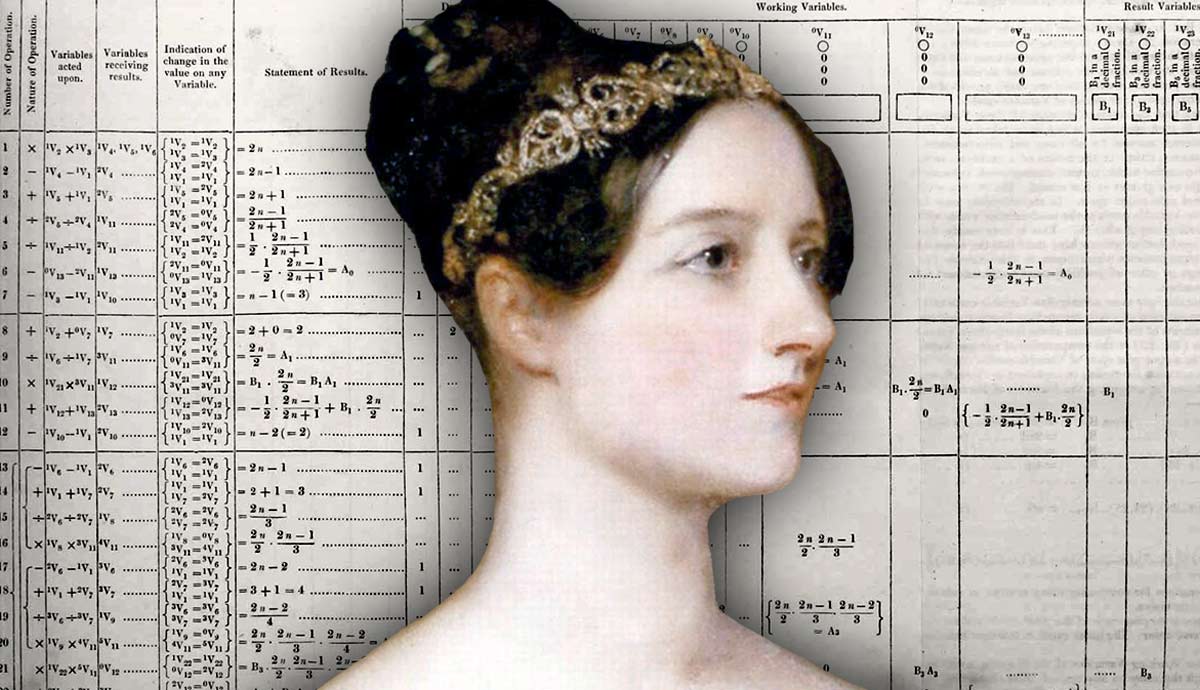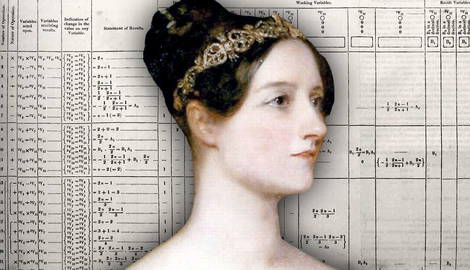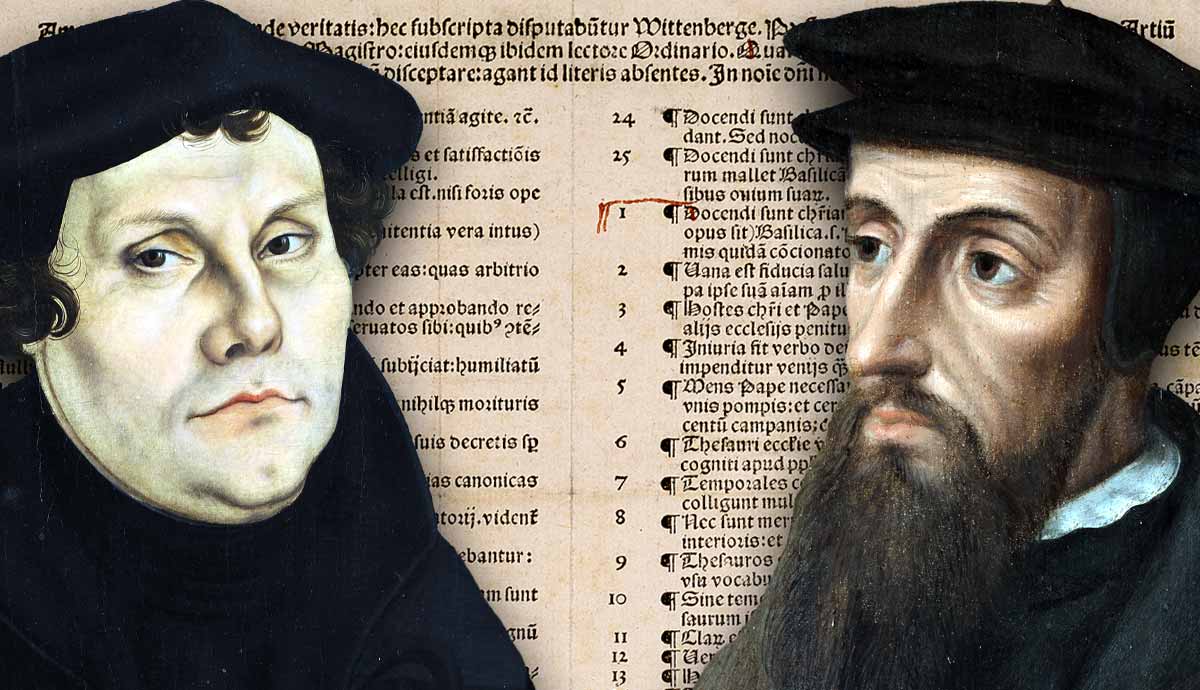
Britain has always been a place of innovation, especially when it comes to science. Isaac Newton and Charles Darwin are obvious examples. Both left a lasting impact on the field of science, and you’d struggle to find a person who didn’t know about these great men. But famous names can sometimes overshadow other individuals who are also worthy of praise.
At a time when female scientists were almost unheard of, an ingenious young woman named Ada Lovelace completed an ingenious piece of work, proving that imagination is a vital part of scientific innovation.
Ada Lovelace’s Childhood: Wealth, Tragedy, & Talent

Ada Lovelace was born in 1815 during the reign of King George III. The Industrial Revolution, which began in the middle of the eighteenth century, was well underway, and Romanticism dominated the world of art and literature.
Ada’s father, Lord Byron, was a famous poet who penned Childe Harold’s Pilgrimage and Don Juan. But he also had a scandalous reputation. In 1812, he had an affair with Lady Caroline Lamb, whose husband later became prime minister.
Just one month after the birth of her daughter, Lady Byron abandoned her scandalous husband. Lord Byron left the country soon after and ended up fighting in the Greek War of Independence against the Ottoman Empire. He died in 1824 after catching a fever, and his body was brought back to England.
His daughter, meanwhile, grew up in Kirkby Hall, which was owned by her grandparents. It was a large, sixteenth-century home built during the reign of Queen Elizabeth I. Here, Ada studied many subjects, including music, grammar, and languages. Acclaimed minds like Augustus De Morgan were brought in as private tutors, providing Ada with an exceptional scientific education.
Though very few scientists were women in the early nineteenth century, this didn’t dissuade Ada. She developed a passion for science during her childhood. When she was just twelve years old, she recorded her plans to develop an early version of something similar to an airplane.
When Ada was thirteen, she became incredibly ill and remained bedridden for more than a year. Despite her poor health, she didn’t mind being isolated and kept herself occupied by studying.
Charles Babbage & the Difference Engine

Ada Lovelace’s scientific obsession led to a meeting with Charles Babbage, the famous mathematician. Born in 1791, Babbage studied at Trinity College, Cambridge, and soon discovered his mathematical skills went far and above many of his tutors. He later co-founded the Analytical Society and became a Fellow of the Royal Society.
Babbage developed an interest in the science of calculating machinery and came up with the design for a device called the Difference Engine. The toolmaker Joseph Clement was responsible for assembling the Difference Engine, but only a fraction of the full machine was finished.
The Difference Engine was made up of rods and pinions, with the numbers represented by metal wheels mounted on columns. Rather than simply performing arithmetic, the machine could calculate a series of numerical values and print the results. This was revolutionary at the time.
In 1833, Babbage invited Ada and several other guests to his home. During the event, the mathematician showed off several machines, including the Difference Engine. Ada was intrigued by the machine. Though still a teenager, she recognized the potential of what was in front of her and formed a friendly relationship with Babbage.
This first meeting between Ada and Babbage was a watershed moment. Though neither of them knew it at the time, their partnership would be a milestone in the history of computer technology.
Programming the Analytical Engine

Ada Lovelace’s fascination with machines never left her. Accompanied by her mother, she visited many factories throughout England and examined the machines. She also befriended a scientist called Mary Somerville, the first female scientist to be published by the Royal Society.
Charles Babbage, meanwhile, was working on his next machine: the Analytical Engine. This machine was a more complex version of the Difference Engine. Inspired by a French textile machine called a Jacquard Loom, the Analytical Engine received instructions from punch cards and carried out mathematical calculations.
Babbage received an invitation from Italian mathematician Giovanni Plana to travel to Turin and talk about the Analytical Engine. Luigi Federico (the future Italian Prime Minister) attended the lecture and was fascinated by Babbage’s machine. He even wrote a paper about the Analytical Engine for a publication in Switzerland.

Ada translated this paper into English, taking the time to add her own observations. These notes were extensive and much longer than the original paper. Ada realized the machine could perform a series of operations beyond simply calculating numbers. The numbers could represent letters and symbols and be used for more creative processes, such as musical composition.
It was Ada’s imagination, alongside her knowledge of science, that allowed her to see the potential of the Analytical Engine. The idea a number could represent something other than a quantity marked the transition from calculation to computation.
Before the translation was published, Ada and Babbage had a disagreement. Babbage wanted the translation to include a section criticizing the government for not funding the creation of the machine. When Ada refused to do this, Babbage became angry and threatened to stop the translation being published. Thankfully, this proved to be an empty threat.
After many eighteen-hour workdays, Ada’s hard work paid off. The translation was published in 1843 in Taylor’s Scientific Memoirs, and it was acclaimed by the scientific community.
Following in Her Father’s Footsteps

Ada Lovelace cemented herself in the history books with this translation. Yet she had no intention of putting a halt to her academic pursuits. Turning her attention to medical science, Ada used her experience with machine technology, believing it would be possible to understand the workings of the body in mathematical terms.
Unfortunately, Ada also followed in the footsteps of her scandalous father. Married to an intellectually inferior husband and devoid of close friends she could confide in, Ada became reliant on alcohol. She also started openly flirting with other men, leading to several scandals.
Worse still, Ada developed a gambling addiction. She enjoyed gambling on horses and even thought it would be possible to develop a formula to calculate the chances of winning. She sometimes financed her gambling habits by pawning her own jewelry.
Now facing an increasing amount of debt, Ada struggled against depression and physical ailments. Alongside her rheumatic attacks, she battled against uterine cancer. This led to severe pain, making it difficult for her to sleep at night.
Ada died on November 27, 1852 at the age of thirty-six. Due to her troubled relationship with her mother, Ada chose to be buried with her father at the Church of St Mary Magdalene in Hucknall, Nottinghamshire.
The Final Years of Charles Babbage

Charles Babbage, on the other hand, lived for much longer. His son Henry returned from India with his wife and child and came to live with Babbage, who provided his grandchild with a nursery. The reunited father and son had a close bond, frequently attending parties and working on mathematics together.
Babbage also continued to work on his plans for the Analytical Engine. While the machine was never physically assembled, his final designs for the machine brought him even closer to the concept of a general-purpose computer.
As he grew older, Babbage became more introspective, reflecting on his life as a mathematician. He started to write a collection of reminiscences entitled Passages from the Life of a Philosopher. Published in 1864, the work was a collection of anecdotes from Babbage detailing his thoughts on science, mathematics, chemistry, geology, astronomy, and religion.
Babbage died on October 18, 1871 at the age of seventy-nine. Though the Analytical Engine never became a reality, it would be wrong to describe Babbage’s career as an unsuccessful one. Just like Ada, this great mathematician left behind an impressive legacy.
Ada Lovelace’s Place in History

Ada Lovelace’s translation was published in 1843, but it was a long time before something resembling a modern-day computer came into existence.
In 1936, the mathematician Alan Turing wrote a paper that became the theoretical basis for the computers we use today. Turing also played a vital role in the Second World War by cracking the German enciphering machine known as Enigma. He completed this task with the help of other mathematicians, such as Gordon Welchman and Hugh Alexander. They accomplished this feat by using a mechanical device known as the Bombe.
In the 1950s, devices resembling the computers we use today started to appear, though they were much larger and mostly used by companies, institutions, and university departments. An obvious example would be the Bendix G-15. This computer was designed by an American scientist called Harry Huskey, who had previously worked with Turing when designing a device known as the Automatic Computing Engine.
Bearing this in mind, the work of Ada Lovelace and Charles Babbage – though highly original – should not be overstated. Indeed, Ada’s work with Babbage remained an obscure detail until Bertram V. Bowden published Faster Than Thought in 1953. In other words, Ada’s achievements outweighed her impact.
Yet the story of this ingenious woman is still worth telling. At a time when female scientists were incredibly rare, Ada used her intellect and imagination in a unique way, surpassing her contemporaries and earning her place in history as the world’s first computer programmer.










